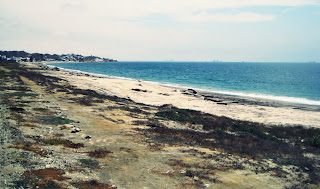I had been warned. The road from Santa Elena to Guayaquil was dangerous, overrun with thieves and bandits. There was a great delinquencia said the owner of the hostal in Montanita. To ride into the city of Guayaquil would be to risk everything another man told me at a roadside snack stand. The delinquents of Guayaquil will take your bicycle and I will read about you, gringo, in tomorrow’s papers. Because of these warnings I was seriously considering packing up the bike and gear at Santa Elena and taking a bus into Guayaquil.
But there were no bike shops in Santa Elena where I could get a bike box, and, anyway, I wasn’t enthusiastic about packing up the bike for just a 150km bus ride. My map indicated a large road that became a toll road as it entered the city. It was the major road between Guayaquil and the coast and there were only a few small pueblos indicated. Where did these delinquents live, I wondered. I checked on the internet and found a couple other riders who had made the trip and had written nothing of the delinquencia. I had a hard time believing there were grave dangers on such an important transportation route.
I decided in the morning at Santa Elena to make the ride. I figured I could do it over three days, riding 50km a day, and make Guayaquil early in the morning of the third day of riding before the criminals and delinquents had awakened. I packed and got on the road just after 7am.
It was cool and wet and soon it began to rain lightly. I put on my rain jacket and bootees and rode the wide shoulder of the well-paved highway. It was mostly flat country with few trees and some banana plantations. In the distance there was a range of low mountains. Trucks and cars passed. There were no houses or pueblos and it was easy, smooth riding on the good pavement. After a couple hours I stopped for a juice at a little roadside stand operated by an old man and woman.
I mentioned where I was going and they did not warn me of delinquents. I then asked about hotels or hostels nearby where I might stay the night. The old woman said there was nothing until Guayaquil, nowhere to stay. I realized I had to do the entire 150km in one day. There was no way around it. I thanked the elderly couple for the information and got back on the road.
I hadn’t ridden over 100km in over a year and I had no idea if my knee could hold out. I also wanted to make sure I made Guayaquil before evening. I had no map of the city and the last thing I wanted was to get lost after nightfall. I also didn’t know what kind of neighborhoods I would need to ride through to get to the city center.
The rolling country began at 75km into the day and with it the sun broke through the clouds and it became very hot. My knee felt good but I could feel myself weakening on the bike. The rollers were killing me and I began stopping at any roadside stand for a short break and a bottle of Coke or juice. The short breaks and simple sugars were just enough to keep off my collapsing and I continued on through pueblos that were gradually larger as I neared Guayaquil.
Then there was a long ride through the outskirts of the city. There were none of the impoverished barrios I had been warned about but instead wealthy, newly constructed gated condo buildings. The shoulder disappeared on the road and I was riding through the rush hour traffic of trucks and cars and school buses. It was brutally hot and polluted and I was gassed and trying hard to concentrate on not getting hit.
I made the city center finally and found the Parque Centenario and from there found the hotel I had written down to stay at. I could hardly communicate with the man at reception. When he finally realized where I had come from he didn’t believe it. I told him again that I had ridden all the way from the coast just today, more than 150km. I could hardly believe it myself.















































